牛津小学英语4B》第四单元教案
牛津小学英语4BU4公开课教案

牛津小学英语4B:Unit4 Buying fruit教学设计一、教学内容《义务教育课程标准实验教科书·牛津小学英语》4B Unit4,第一课时(A. Read and say 和B. Look,read and learn)二、教学思路1、本课的重点句型What are these/those? They’re … 与4A中已学过的What’s this/that? It’s…句型类似,学生容易理解与接受,所以我采用了以旧带新的方法,将此点破。
但是学生对these与those的发音上有困难,因此,在教学过程中,我注重了这两个词读音教学。
2、四年级学生争强好胜的心理较强,为发挥这一优势,我采用多种活动形式形式,贯穿整个课堂教学活动,充分调动学生的学习积极性。
3、在课文的对话教学中,我努力采用了情景教学法,营造学生购物的真实情景,促进学生理解和运用新知。
三、教学目标(一)语言知识目标1、能听得懂、会说、会读和会拼写单词apples, oranges, bananas, peaches, grapes, pineapple, watermelon, pears.2、能听得懂、会说、会读和会写句型What are these/ those? They’re…How many kilos? …kilos, please.3、能听得懂、会说和会读日常交际用语Can I help you? I’d like some…4、正确理解课文内容。
(二)语言技能目标:能根据单词和情境正确运用句型What are these/ those? They’re…I’d like some…How many kilos? …kilos, please.并在设置的情境中正确运用以上单词和句型进行简单交流。
(三)情感态度目标1、培养学生大胆开口说、开口演、开口练的习惯。
2、让学生学会如何购物以及礼貌地使用交际用语。
四、授课类型:新授课五、教学方法:为了更好的实现教学目标,有效地突破重点、难点,依据现代认知理论及教学模式,在教学过程中,我采用了以下教学方法:1、知识迁移法:即以旧带新,以旧单词引出本课重点句型,以单数句型引出复数句型,举一反三,发挥学生的创造力,训练学生的发散思维能力。
牛津版小学英语4B Unit 4 Buying fruit Ⅰ教学设计
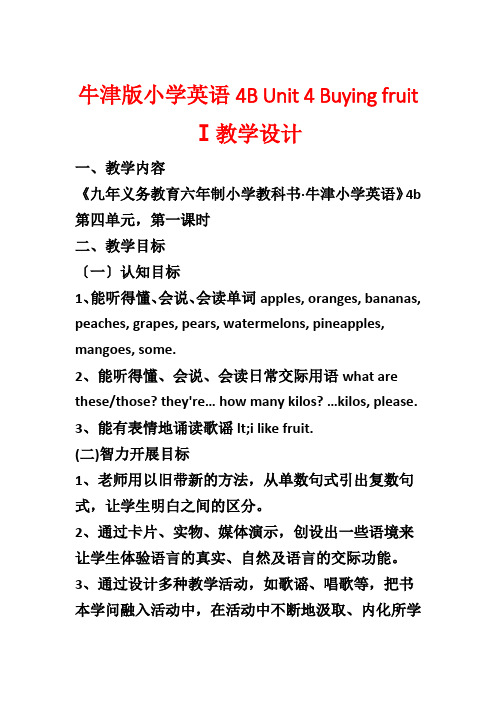
牛津版小学英语4B Unit 4 Buying fruitⅠ教学设计一、教学内容《九年义务教育六年制小学教科书·牛津小学英语》4b 第四单元,第一课时二、教学目标〔一〕认知目标1、能听得懂、会说、会读单词apples, oranges, bananas, peaches, grapes, pears, watermelons, pineapples, mangoes, some.2、能听得懂、会说、会读日常交际用语what are these/those? they're… how many kilos? …kilos, please.3、能有表情地诵读歌谣lt;i like fruit.(二)智力开展目标1、老师用以旧带新的方法,从单数句式引出复数句式,让学生明白之间的区分。
2、通过卡片、实物、媒体演示,创设出一些语境来让学生体验语言的真实、自然及语言的交际功能。
3、通过设计多种教学活动,如歌谣、唱歌等,把书本学问融入活动中,在活动中不断地汲取、内化所学的语言材料。
〔三〕情感目标把语言训练融入各种情景及活动之中,努力营造一种开心轻松的教学气氛,让学生充溢乐趣地学习。
三、教学重点本课的新词、句型及对话的教学。
四、教学难点本课句型的理解及运用。
五、课前打算1、教具打算:多媒体课件、画有水果的图片8张〔apples, oranges, bananas, peaches, grapes, pears, watermelons, pineapples, mangoes〕。
2、教学打算:请学生自己带上一、二件水果或带画有水果的图片假设干3、板书打算:黑板上预先写上unit 4 buying fruit五、教学过程:a、prepare for the class1、sing a song lt;can i help you?2、greeting以good morning/afternoon,boys and girls. how are you?等和同学们打招呼,学生依照实际情形答复。
4b unit4教案
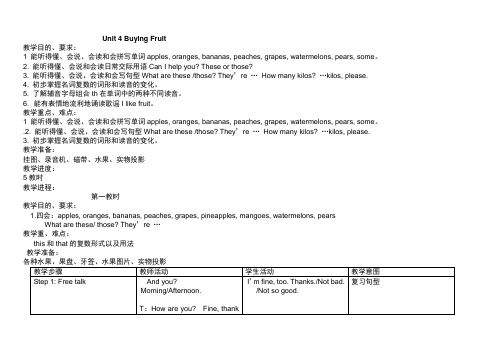
Unit 4 Buying Fruit教学目的、要求:1 能听得懂、会说、会读和会拼写单词apples, oranges, bananas, peaches, grapes, watermelons, pears, some。
2. 能听得懂、会说和会读日常交际用语Can I help you? These or those?3. 能听得懂、会说、会读和会写句型What are these /those? They’re …How many kilos? …kilos, please.4. 初步掌握名词复数的词形和读音的变化。
5. 了解辅音字母组合th在单词中的两种不同读音。
6. 能有表情地流利地诵读歌谣I like fruit。
教学重点、难点:1 能听得懂、会说、会读和会拼写单词apples, oranges, bananas, peaches, grapes, watermelons, pears, some。
.2. 能听得懂、会说、会读和会写句型What are these /those? They’re …How many kilos? …kilos, please. 3. 初步掌握名词复数的词形和读音的变化。
教学准备:挂图、录音机、磁带、水果、实物投影教学进度:5教时教学进程:第一教时教学目的、要求:1.四会:apples, oranges, bananas, peaches, grapes, pineapples, mangoes, watermelons, pearsWhat are these/ those? They’re …教学重、难点:this和that的复数形式以及用法教学准备:第二教时1.教学目的、要求:四会:What are these/those? They’re …How many kilos? …kilos, please.了解辅音字母组合th在单词中的两种不同读音。
津小学英语4B Unit4Buying fruit

津小学英语4B Unit4 Buying fruit教学内容:《牛津小学英语》Unit 4 Buying fruit Part A教学背景:1.面向学生:小学四年级2.学科、年级、课题:苏教版牛津小学英语Unit 4 Buying fruit3.设计思路:本单元主要围绕的是如何购买东西展开的,让学生掌握最基本的日常购买用语,即激发学生的学习兴趣,又让学生真真实实的掌握。
所以,根据以上教材分析,本课的重点是让学生能听懂、会说、会读,会拼写单词grapes,pears,some;能听懂,会说,会读,会写句型“What’s are these/those?They’re…I’d likesome…,please.How many kilos?…kilos,please.教学难点是these/those的正确发音,并能灵活运用到本单元的句型中。
让学生调查所喜欢的水果,使学生做到“做中学,玩中学”。
教材分析:本单元主要围绕的是如何购买东西展开的,让学生掌握最基本的日常购买用语,即激发学生的学习兴趣,又让学生真真实实的掌握。
教学目标:1、知识目标:a、能听懂,会说,会读,会写单词grapes,pears, ,some.b、能听懂,会说,会读,会写句型what are these/those? They’re...I’d like some…,please. How many kilos?....kilos, please.2、技能目标:初步运用购物的日常交际用语开展实践性购物活动,将英语学习活动融于真实的生活中。
3、情感态度目标:让学生根据生活体验表达自己的感受,使学习活动因富有生活气息而洋溢生机和活力。
通过多种形式的活动激发学生的学习兴趣。
教学重点:a、能听懂,会说,会读,会写单词grapes,pears, ,some.b、能听懂,会说,会读,会写句型what are these/those? T hey’re...I’d like some…,please. How many kilos?....kil os, please.教学难点:1、能正确理解掌握对话内容,能朗读并初步表演对话。
牛津小学英语4B Unit4 Part A 教案
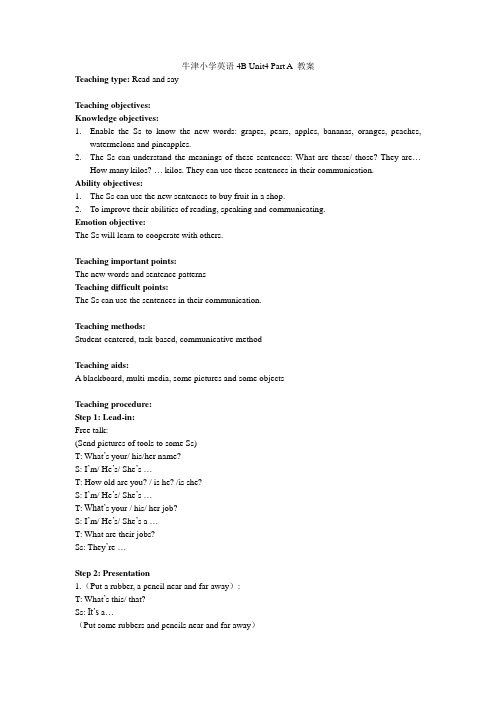
牛津小学英语4B Unit4 Part A 教案Teaching type: Read and sayTeaching objectives:Knowledge objectives:1.Enable the Ss to know the new words: grapes, pears, apples, bananas, oranges, peaches,watermelons and pineapples.2.The Ss can understand the meanings of these sentences: What are these/ those? They are…How many kilos? … kilos. They can use these sentences in their communication.Ability objectives:1.The Ss can use the new sentences to buy fruit in a shop.2.To improve their abilities of reading, speaking and communicating.Emotion objective:The Ss will learn to cooperate with others.Teaching important points:The new words and sentence patternsTeaching difficult points:The Ss can use the sentences in their communication.Teaching methods:Student-centered, task-based, communicative methodTeaching aids:A blackboard, multi-media, some pictures and some objectsTeaching procedure:Step 1: Lead-in:Free talk:(Send pictures of tools to some Ss)T: What’s your/ his/her name?S: I’m/ He’s/ She’s …T: How old are you? / is he? /is she?S: I’m/ He’s/ She’s …T: What’s your / his/ her job?S: I’m/ He’s/ She’s a …T: What are their jobs?Ss: They’re …Step 2: Presentation1.(Put a rubber, a pencil near and far away):T: What’s this/ that?Ss: It’s a…(Put some rubbers and pencils near and far away)T: What are these/ those? They’re…Ss: They’ re rubbers./pencils.(Write the sentences on the Bb and teach the Ss to read them.)2. Play a guessing game(Cover parts of the pictures and let the Ss to ask or guess)What are these? /What are those?They’re…3.Let’s chant:These, these, what are these?Apples, apples, they are apples.Those, those, what are those?Grapes, grapes, they are grapes.(Boys read the former parts and girls the later parts.)4.I’d like…我想要…(I’d like a panda.)5.T: I’d like some oranges. I buy some oranges here. How many oranges?How many kilos?(公斤)Two kilos.(Teach the Ss to read : How many kilos? Two kilos.)T: I’d like some watermelons. How many watermelons? How many kilos?Five kilos.(Teach the Ss to read: How many kilos? Five kilos.)6.Say a chant:How many, how many, how many kilos?One kilo, two kilos, three kilos;Four kilos, five kilos, six kilos;Seven kilos, eight kilos, nine kilos;I’d like nine kilos.Step 3: Practice:1.T: Open your books to page 30. Read the dialogue in Part A and then answer these T/F Qs.1 Miss Li wants to buy some oranges and grapes. ( )2 Miss Li wants one kilo of grapes. ( )3 Miss Li wants three kilos of pears. ( )4 The man in the picture is a worker. ( )The keys: F F T F2.T: Fill in the blanks1. This is a . These are .2. That is a . Those are .3. Miss Li wants(想要) to buy kilos of pears.4. Miss Li wants(想要) to buy kilos of grapes.Step 4 : Consolidation1.Read the dialogue after the teacher.2.Read the dialogue in roles with your partners.3.Read it in roles. (Boys act as the farmer and girls act as Miss Li.)4.Show the title: Unit 4 Buying fruit5.Act how to buy fruit using the sentences:A: Can I help you?B: I’d like some …, please.A: How many kilos?B: … kilo(s), please.A: Here you are.B: Thank you.(They can use the pictures of fruit. Teacher and a student act firstly and then ask some pairs to act.)Step 5: Homework1. Read the dialogue after the tape.2. Act the dialogue out with your friends.Blackboard design:Unit 4 Buying fruitWhat are these?They’re…What are those?They’re…Reflections: 在整个教学环节中我借助图片、多媒体等教学辅助手段创设了轻松活泼的氛围。
4B Unit4 Buying fruit教案

4B Unit4 Buying fruit一、学情分析:牛津小学英语4B第四单元Buying Fruit 核心内容是“认物”,是个能激发学生积极性的单元。
本单元含有大量的水果名称,孩子大都对吃的东西比较感兴趣,因此能够用多种成功激励的手段来激发学生学习英语的兴趣,促使学生自主地、积极地、探索性地参与到学习中去,在学好知识的同时,掌握有效的学习方法,形成良好的学习品质,获得成功的体验。
二、教学目标1.了解:水果单数变为复数时,词尾要加上s或者es;在what开头的特殊疑问句中,随着名词由单变为复,be动词和指示代词也要发生相应的改变。
2.识记:单词:these, those, pears,grapes.句型:What are these/ those? They’re …3.理解:能听懂、会读、会运用对话中的日常交际用语:What are these? What are those?They’re……。
强调复数概念,突破难点;正确使用新授指示代词these/those。
4.积累与运用:复习已学的八种水果类单词;能正确运用所学句型完成一系列对话;读准并区别运用these/those5. 过程与方法:运用板书和课件突出重点;以“买水果”这一情境贯穿整节课堂;结合课堂练习纸完成知识的总结与反馈。
6. 情感态度与价值观:在英语课堂教学中提高学生学习英语的兴趣和积极性,将所学的语言与生活相结合,设置情境,自编对话。
并能培养学生自主学习英语的能力和运用英语分析、解决问题的能力以及交流和合作的能力。
三、教材分析牛津小学英语4B第四单元Buying Fruit以Miss Li和farmer 的购物对话展开,引出新词“grapes”和一系列购物用语的教学。
“grapes”这种水果第一次出现,可采取游戏的方式的方式来复习4A时所学的水果,自然引出“grapes”的教学。
本课中,单复数的转换是教学重点,所以可以在教学中可采用以旧带新的方法,从单数词,句引出复数词,句。
牛津小学英语4B Unit 4 Buying fruit教学设计

4B Unit 4 Buying fruit (牛津小学英语)教学活动案例课题说明本课适合于小学四年级的学生,选自牛津小学英语4B Unit 4 Buying fruit.本课主要学习单词,如buy some等。
日常交际用语:I’d like some …,please.及句型:What’s are these/those? They’re… How many kilos? … kilos, please.课时说明本案例是第四单元的第一课时(A Read and say)。
这节课的教学任务是,如何通过认物到购物,真正达到学以致用。
学生情况说明学生们在Book 4A中已经学习了What’s this/that? It’s …句型。
此外,在Book 3A第三单元中学习了部分水果单词并掌握的非常好,这为本单元的教学内容提供了有利的基础。
本单元的教学内容与学生的日常生活息息相关,因而本单元的教学内容对学生来说并不难,关键是如何应用到实际生活中去。
在教学时,我通过创设购物情景,开展灵活多样的教学活动,从而让学生掌握所学知识,更好的运用到生活中去。
教学设计教学目标:1. 能听懂、会说单词buy, some。
2. 能听懂、会说、会读句型I’d like some …, please . What are these/those? They’re … How many kilos? … kilos, please. 并获得运用所学语言进行交际的能力。
要求读音正确,语调自然。
教学重点、难点:能正确理解运用句型What are these/those? They’re … How many kilos? …kilos, please.教具、学具准备:CAI、头饰、秤、招聘广告、招聘证书教学步骤:Step 1 Warm up1. GreetingsT: Good morning, boys and girls. Ss: Good morning, Miss Ding. T: How are you? Ss: I’m fine, and you?T: I’m fine, too.2. Sing a songT:Boy and girls, are you happy? Ss: Yes, we are.T: OK. Let’s sing a song. They sing happily. (CAI放音乐,老师与学生一起唱歌,做相应的动作。
牛津小学英语互联网教案4B Unit4 Buying fruit

Unit 4 Buying fruit A 部分教案连云港市岗埠中心小学何叶一、教学内容《义务教育课程标准实验教科书.牛津小学英语》4B第四单元第一教时(Look read and learn)二、教学目标1、能正确地听、说、读、写词apples .oranges.peaches.grapes.bananas.pears.2、能正确地听、说、读单词pineapples.watermelons.3、能正确地听、说、读句子What are these/those?They're…How many kilos?...kilos,please.三、教学重点:能正确地听、说、读、句子What are these/those?They're….四、教学难点1、能正确使用句型What are these/those?They're….单词some、kilo、grape的发音五、课前准备1、教具准备:课件、单词卡片、水果图片、水果实物、秤。
2、板书准备:黑板上预先写好课题Unit4 Buying fruit教学过程Step1: Greeting and lead in.1、T: Good moring,boys and girls.S: Good moring,Miss He.T: First,Let’s play a game, guess!It’s round and red.And it’s very juicy(多汁的)What’t it?S: It’s apple!T:Yes!look, What’s this?S:It’s an apple.T:And what’s that?S:It’s a pear!T:Thank you.T:Please look at here, what’s this? Read after me :grape(单词卡片呈现、小组开火车朗读)T:What are these?由复数水果呈现引导学生说 They are grapes.接着老师指着远处桌上的水果问:What are those?帮助学生通过教师所指的方向不同区分these、those.2、chant引导学生在看到老师指近处的水果(复数实物呈现)时,拍手说:What,what,what are these?Pears,pears ,they’re pears.当老师指着远处水果时可以说What,what,what are those?Grapes,grapes,they’re grapes.Step2:Presentation and practic1、展示课件/view/d5fb8e33a32d7375a41780da.利用水果单词复习I’d like...句型,引导学生认知。
4B unit 4 教案

4B Unit4 第一课时教学案例教学内容:《牛津小学英语》4B第四单元第一课时的教学内容。
本单元的核心教学内容“认物”,本课时的教学重点是学习有关的水果的单词及日常用语What are these? They’re …What are those? They’re … H ow many kilo? … kilos.教学目标:知识目标:①学生能够听懂、会说、会拼、会写水果类单词:apples, oranges, bananas, peaches, grapes, pineapples.②学生能够听懂、会说、会读、会写句型:What are these? They’re … What are those? They’re … H ow many kilo? … kilos.能力目标培养学生在游戏中熟练运用单词的能力,灵活运用交际用语的能力和知识迁移的能力。
情感目标:①学生通过合作学习能够形成一定的团队精神与协作能力。
②在学习、应用本课知识的过程中,培养发散思维、创造思维的能力。
教学重难点:(一)重点①四会单词apples, oranges, bananas, peaches, grapes的拼写及单复数形式②熟练灵活地在情景中运用日常用语What are these? They’re …What are those? They’re … H ow many kilo? … kilos.正确使用these与those,能区分出两者的远近关系。
教学准备:多媒体课件、小礼物、学生准备好水果与购物的道具Step1 GreetingsT: Nice to see you , boys and girls . Today I’m your new English teacher . you can call me Mr Wang . And there’s an apple tree over there . You can have a match . If you are better , you can pick an apple . Now let’s begin our class .设计意图:在开始就引入评价机制有助于学生尽快的融入课堂气氛并能提升竞争意识,激发学生的主动学习意识。
创设教学情境 发展想像空间——牛津小学英语4B Unit4教学方案
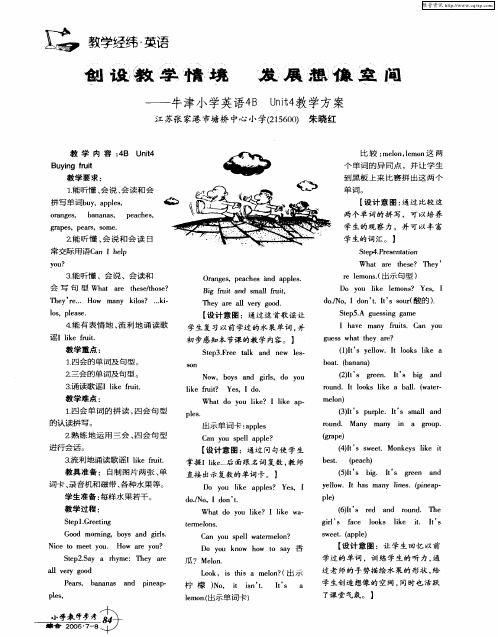
( ae r g p)
() ’ s e t 4I S w e.Mo k y ie i t n es l t k
【 设计意 图 :通过 问句使 学生
掌握 Il e 面跟名 词复数 , 师 i …后 k 教
bs et .
p ah ec)
教具 准备 :自制 图片两张 、 单
词 卡 、 音机 和 磁 带 、 种 水 果 等 。 录 各
【 设计 意 图 : 过 比较 这 通
两个单 词的拼 写 ,可 以培 养 学生的观察 力 ,并 可 以丰 富
ga e ,p a ,s rp s er s ome ・
2能 听 懂 、 说 和 会 读 日 会 常 交 际 用 语 C n Ih l a e p
y ? ou
学生的词汇。 】
a a e h s ? T e ’ t r t e e h y
3 听懂 、会 说 、会 读和 . 能 会 写 句 型 Wht r tee h s? a ae h s/ oe t
T e ’e h y r… Ho w ma y i s …k - n k l ? o i
r e n .出 示句 型 ) el mo s(
S n O
u s a h y a g e s wh t t e l ? e
教学重点 :
1四 会 的 单词 及 句 型 。 . 2 会的单词及句型 。 . 三 3诵读 歌 谣 Il ef i . i r t k u .
() ’ yl w tl k ie a 1h S e o .I o s l l o k
b a. b n n ) o t a a a
No , b y a d il, d y u w o s n g r s o o lef i i r t k u ? Ye ,Id . s o
《牛津小学英语4B》Unit 4 参考教案

牛津小学英语4B Unit 4 参考教案教学目标1.学生能够听懂、认读并正确运用本单元的重点词汇和句型。
2.学生能够通过听说练习,掌握本单元对话和短文的基本技巧。
3.学生能够通过阅读练习,提高阅读理解能力。
4.学生能够通过写作练习,运用本单元所学的句型和词汇进行简单的书面表达。
教学重点1.单词和短语:play chess, club, play football, jump rope, collect stamps, collection, short, tall, thin, fat。
2.句型:What sports do you like? I like swimming. Which collection do you like?I like collecting stamps. How tall are you? I’m 150 centimeters.教学准备1.教学课件。
2.黑板、白板或投影仪。
3.学生用书。
教学过程导入与复习 (5分钟)1.复习上一单元所学的重点词汇和句型。
2.通过问答和游戏形式,激发学生对英语学习的兴趣。
新课呈现 (10分钟)1.通过图片和幻灯片展示本单元所学的重点词汇,并引导学生读音和意思。
2.分角色朗读对话,模仿语音语调和表情,帮助学生理解对话场景和语言表达。
听力训练 (15分钟)1.听录音,学生按照录音内容判断图片与录音是否相符。
2.听录音,学生根据听到的信息回答问题或完成练习册上的题目。
口语练习 (20分钟)1.学生分组进行问答练习,模仿对话表达自己的喜好。
2.学生根据展示的图片进行对话练习,使用所学句型和词汇进行交流。
阅读训练 (15分钟)1.学生阅读课本上的文章,回答问题并进行分组讨论。
2.学生阅读练习册上的阅读理解题目,完成相应的任务。
书面表达 (15分钟)1.学生根据提示写一篇短文,介绍自己的喜好和特点,使用本单元所学的句型和词汇。
2.学生交换作文并进行互评,给予建议和提供改进意见。
牛津小学英语 4B Unit 4 Buying fruit

牛津小学英语 4B Unit 4 Buying fruit (第一课时)梅堰实验小学吴阿二 215225一、课题:《牛津小学英语》4B第四单元第一教时二、教材简解:《牛津小学英语》4B第四单元第一课时的教学内容。
本课的教学重点是学习有关的水果的单词及日常用语What are these? They’re … What are those? They’re …三、目标预设:(一)认知目标1、能听得懂、会说、会读单词apples, oranges, bananas, peaches, grapes, pears, watermelons, pineapples, mangoes.2、能听得懂、会说、会读日常交际用语What are these/those? They’re… How many kilos? …kilos, please.3、能有表情地诵读歌谣(二)能力目标1、教师用以旧带新的方法,从单数句式引出复数句式,让学生明白之间的区别。
2、通过卡片、实物、媒体演示,创设出一些语境来让学生体验语言的真实、自然及语言的交际功能。
3、通过设计多种教学活动,如歌谣、唱歌等,把书本知识融入活动中,在活动中不断地吸收、内化所学的语言材料。
(三)情感目标把语言训练融入各种情景及活动之中,努力营造一种愉快轻松的教学氛围,让学生充满乐趣地学习。
四、教学重难点:(一)重点1、四会单词apples, oranges, bananas, peaches, grapes与句型What are these? They’re …What are those? They’re …2、熟练灵活地在情景中运用日常用语What are these? They’re …What are those? They’re …(二)难点1、四会单词apples, oranges, bananas, peaches, grapes的拼写2、正确使用these与those,能区分出两者的远近关系。
牛津小学英语4B全册教案4BUnit4Buyingfruit(PartA)教案

牛津小学英语4B全册教案4BUnit4Buyin gfruit(PartA)教案Teaching plan of 4B unit 4B fruit (part a)牛津小学英语4B全册教案4BUnit4Buyingfruit(PartA)教案前言:小泰温馨提醒,英语作为在许多国际组织或者会议上都是必需语言,几乎所有学校选择英语作为其主要或唯一的外语必修课。
英语教学涉及多种专业理论知识,包括语言学、第二语言习得、词汇学、句法学、文体学、语料库理论、认知心理学等内容。
本教案根据英语课程标准的要求和针对教学对象是小学生群体的特点,将教学诸要素有序安排,确定合适的教学方案的设想和计划、并以启迪发展学生智力为根本目的。
便于学习和使用,本文下载后内容可随意修改调整及打印。
4b unit4 buying fruit (part a)teaching plan1.能听懂、会说单词buy, pears, grapes, some。
2.能听懂、会说、会读句型what are these/those?they’re … how many kilos? … kilos, please. 并获得运用所学语言进行交际的能力。
要求读音正确,语调自然。
keystone and difficulties:1.能正确理解运用句型what are these/those?they’re … how many kilos? … kilos, please.time:25minsstep one: warm up and lead intime:5mins1.t: hello, boys and girls. nice to see you.t: look, this is a fruit. what’s this? guess! (show a shape of a pear)yes, it’s a pear. (出示清楚的图片)t: (呈现问句和三个梨子的图片)what are these?(呈现答句)they’re pears.(带读两遍,拼读一遍)2.t: 刚才有一个梨子,用什么句子提问的呢?what’s this?近处有三个梨子,又是怎么提问的呢?出示what are these?(呈现句子,带读两遍,学生看老师口型)在这里,these是“这些”的意思。
牛津小学英语4BUnit4第一课时教案
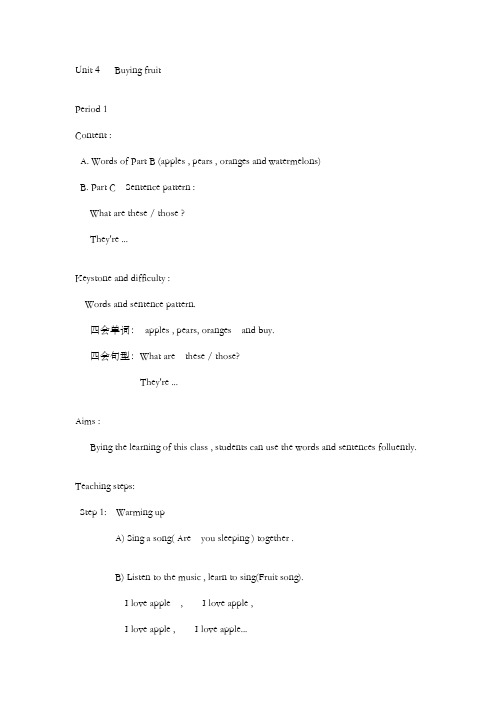
Unit 4 Buying fruitPeriod 1Content :A. Words of Part B (apples , pears , oranges and watermelons)B. Part C Sentence pattern :What are these / those ?They're ...Keystone and difficulty :Words and sentence pattern.四会单词:apples , pears, oranges and buy.四会句型:What are these / those?They're ...Aims :Bying the learning of this class , students can use the words and sentences folluently. Teaching steps:Step 1: Warming upA) Sing a song( Are you sleeping ) together .B) Listen to the music , learn to sing(Fruit song).I love apple , I love apple ,I love apple , I love apple...The two songs have the same tone. Most of the students can sing with the tone of Two Tigers. By this way students can contact with the new words with a direct interest.Try their best to sing ,and get the pronunciation and meaning of the new words by themselves.Step 2: RevisionA) Freetalk with daily English.B) Bying freetalk , review the sentence :What's this / that ?It's a /an ...By the reviewing of the sentences , teaching the new words and preparing for the new sentences.Step 3: PresentationA) By warming up and dialogues, appears the new words of thisclass . In two ways, both on the blackboard and cards.1) Let the students guess the pronunciation by themselvesand read for us .2)Teach the reading and do group reading .3)Roleplay and strengthen the grasp of the words.Game : Hot and Cold.Find the words that the teacher hid . According to the students' voice . If high you are near the word and low ,you are far from it .4)Group reading and show the plural form of the words . just add "s"to each of them .B) Sentences teaching .1) Add the words into the sentence patternWhat's this / that?It's an apple / orange (a pear/ watermelon)2) Review the plural form and the numbers.3) Apperance of the sentences :What are these /those ?They're ...By objects " What are they ?"Two groups of objects , here an there,both in single and plural.By compare , help the student understand the meaning and usage of the sentences:What are these / those?They're ...Step 4: Practice.A) Open the book to Page 33 . Do pair work of Part C.Use the words we have learned this class .Ask four groups of students making dialogues for us .And the read after the teacher of the sentences together.B) Role play :Ask and answer with the sentences , use the objeects we often use .For example : rulers , tapes ,rubbers and so on.Students can played as a train. One ask ,one answer . Then the answered one can choose another to answer his question.Step 5: ComfirmationA) ListenningListen to the tape of the words and Part CB) ReadingRead after the tape or the teacher one by one .C) Give the students time to recite the words in class. Help them andteach them the method.Step 6: HomeworkA) Copy and recite the words .B) Make groups of dialogue with the sentences , write down.C) Try to sing the Fruit song.教学思路:本课时为Unit 4第一课时的教学流程。
牛津小学英语4B全册教案
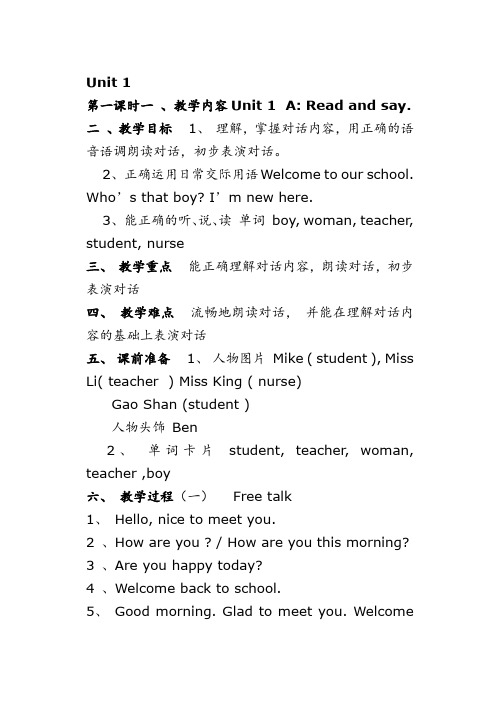
Unit 1第一课时一、教学内容Unit 1 A: Read and say.二、教学目标1、理解,掌握对话内容,用正确的语音语调朗读对话,初步表演对话。
2、正确运用日常交际用语Welcome to our school. Who’s that boy? I’m new here.3、能正确的听、说、读单词boy, woman, teacher, student, nurse三、教学重点能正确理解对话内容,朗读对话,初步表演对话四、教学难点流畅地朗读对话,并能在理解对话内容的基础上表演对话五、课前准备1、人物图片Mike ( student ), Miss Li( teacher ) Miss King ( nurse)Gao Shan (student )人物头饰Ben2、单词卡片student, teacher, woman, teacher ,boy六、教学过程(一) Free talk1、Hello, nice to meet you.2 、How are you ? / How are you this morning?3 、Are you happy today?4 、Welcome back to school.5、Good morning. Glad to meet you. Welcomeback to school.(二) Presentation and practice: Ask and answer1、Good morning, boys and girls . Glad to meet you . Welcome back to school. 出示Welcome back to school. 理解并领读。
2、I have many pictures here .I like them very much. Do you like them?出示所有的图片3、根据出示的照片复习单词boy , girl,man, woman4、Do you know these boys and girls? (出示Mike , Gao Shan, NancyDavid, Helen 的照片):(1) Who’s this boy? (Who’s that boy?) He’s _______. He’s a student. (学习新单词student )(2) Who’s this girl? (Who’s that girl?) She’s _________. She’s a student.5、Do you know these men and women?( 出示Miss Li, Miss GaoMiss King , Mr Green, Mrs Green 的照片)(1)Who’s this man? ( Who’s that man?)He’s _________. He’s a teacher.(学习新单词teacher)(2) Who’s this woman?(Who’s that woman)She’s __________. She’s a nurse. (学习新单词nurse?)(三) Play a game (通过游戏复习并学习新的日常交际用语)1、闭上眼睛猜一猜:(1) A: Who’s that ______?B: He’s(She’s) ________.A: He’s (She’s) a _________.B: You’re right. ( You’re wrong)(2) A: Excuse me. Are you _______?B:: No, I’m not.A: Are you _________?B: Yes , I am.2、让一学生戴上Ben 的头饰让另一学生猜T: Who’s this boy?S: He’s ________.T: No, you’re wrong.S: Are you ________?B: No, I’m not.S: Are you _________?B: No, I’m Ben.(四)Work in pairs1、Ben与老师对话:A: Hello, I’m Ben. I’m new here.B: Hello, I’m Miss Li. Nice to meet you. Welcome to our school.学习: I’m new here.Welcome to our school.2、学生与Ben 对话(五)朗读课文1、听录音,跟读。
牛津小学英语优秀教案4B Unit4 Buying fruit
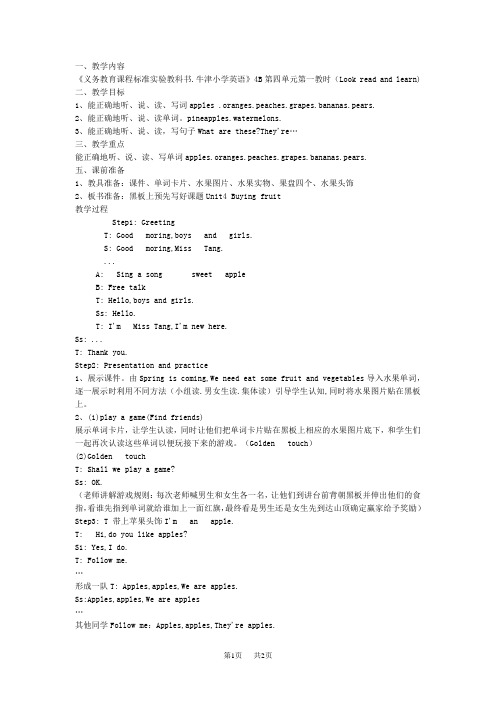
一、教学内容《义务教育课程标准实验教科书.牛津小学英语》4B第四单元第一教时(Look read and learn)二、教学目标1、能正确地听、说、读、写词apples .oranges.peaches.grapes.bananas.pears.2、能正确地听、说、读单词。
pineapples.watermelons.3、能正确地听、说、读,写句子What are these?They're…三、教学重点能正确地听、说、读、写单词apples.oranges.peaches.grapes.bananas.pears.五、课前准备1、教具准备:课件、单词卡片、水果图片、水果实物、果盘四个、水果头饰2、板书准备:黑板上预先写好课题Unit4 Buying fruit教学过程Step1: GreetingT: Good moring,boys and girls.S: Good moring,Miss Tang....A: Sing a song sweet appleB: Free talkT: Hello,boys and girls.Ss: Hello.T: I'm Miss Tang,I'm new here.Ss: ...T: Thank you.Step2: Presentation and practice1、展示课件。
由Spring is coming,We need eat some fruit and vegetables导入水果单词,逐一展示时利用不同方法(小组读.男女生读.集体读)引导学生认知,同时将水果图片贴在黑板上。
2、(1)play a game(Find friends)展示单词卡片,让学生认读,同时让他们把单词卡片贴在黑板上相应的水果图片底下,和学生们一起再次认读这些单词以便玩接下来的游戏。
(Golden touch)(2)Golden touchT: Shall we play a game?Ss: OK.(老师讲解游戏规则:每次老师喊男生和女生各一名,让他们到讲台前背朝黑板并伸出他们的食指,看谁先指到单词就给谁加上一面红旗,最终看是男生还是女生先到达山顶确定赢家给予奖励)Step3: T 带上苹果头饰I'm an apple.T: Hi,do you like apples?S1: Yes,I do.T: Follow me.…形成一队T: Apples,apples,We are apples.Ss:Apples,apples,We are apples…其他同学Follow me:Apples,apples,They're apples.Ss:…T: What are these?Ss:...教师在说句子时把句型写到黑板上,然后教师把四个小组命名为Grape team,banana team...开始操练句型...Practice: Work in pairsT让一个同学配合用“What are these?"They're…句型编对话,让各组学生模仿,给他们两分钟时间自由讨论,组对话。
牛津小学英语4BUnit4第4课时教案
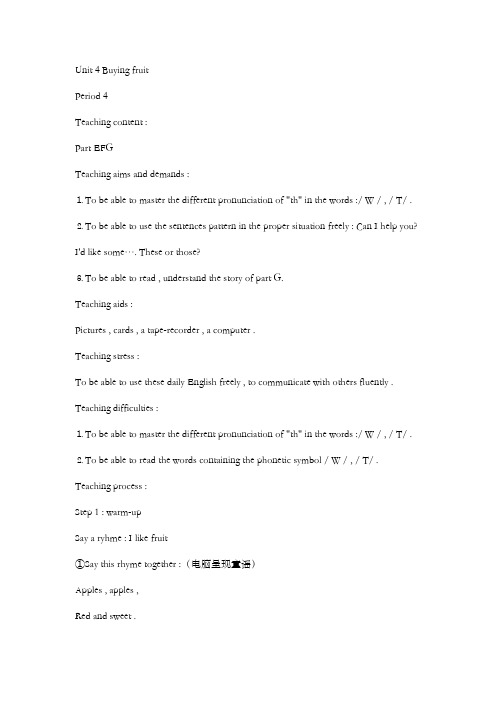
Unit 4 Buying fruitPeriod 4Teaching content :Part EFGTeaching aims and demands :⒈To be able to master the different pronunciation of "th" in the words :/ W / , / T/ .⒉To be able to use the sentences pattern in the proper situation freely : Can I help you? I'd like some…. These or those?⒊To be able to read , understand the story of part G.Teaching aids :Pictures , cards , a tape-recorder , a computer .Teaching stress :To be able to use these daily English freely , to communicate with others fluently . Teaching difficulties :⒈To be able to master the different pronunciation of "th" in the words :/ W / , / T/ .⒉To be able to read the words containing the phonetic symbol / W / , / T/ . Teaching process :Step 1 : warm-upSay a ryhme : I like fruit①Say this rhyme together :(电脑呈现童谣)Apples , apples ,Red and sweet .I like to eat .Bananas and pears ,Green and yellow .Eat them tomorrow.②Ask the students to change other fruit to say this ryhme in a creative way. Step 2 : revision⑴Review the words :(单词卡片贴在黑板上)pear , grape , apple , orange , banana , peach , some , buy .T : Let's play a game , OK ?Ss: OK.T : Now, follow me.全班分成男女生两大组①男生组的一名同窗报单词pear, 女生组的一同窗当即拼读:p-e-a-r,pear .②男生组的一名同窗拼读g-r-a-p-e,女生组的一同窗当即读出单词:grape.回答正确得分,不然另一组得分。
- 1、下载文档前请自行甄别文档内容的完整性,平台不提供额外的编辑、内容补充、找答案等附加服务。
- 2、"仅部分预览"的文档,不可在线预览部分如存在完整性等问题,可反馈申请退款(可完整预览的文档不适用该条件!)。
- 3、如文档侵犯您的权益,请联系客服反馈,我们会尽快为您处理(人工客服工作时间:9:00-18:30)。
牛津小学英语4B》第四单元教案盐城小学英语组Unit 4 Buying fruit(第一课时)一、教学内容《九年义务教育六年制小学教科书·牛津小学英语》4B第四单元第一课(Read and say)二、教学目标1.能听得懂、会说、会读和会拼写单词apples, oranges, bananas, peaches, grapes, watermelons, pears, some。
2.能听得懂、会说和会读日常交际用语Can I help you? These or those?3.能听得懂、会说、会读和会写句型What are these/those? They‟re….How many kilos? … kilos, please.4.初步掌握名词复数的词形和读音的变化。
5.了解辅音字母组合th在单词中的两种不同读音。
6.能有表情地流利的诵读歌谣《I like fruit》。
三、教学重点能正确理解对话内容,朗读对话,初步表演对话四、教学难点流畅地朗读对话,并能在理解对话内容的基础上表演对话五、课时安排: 四课时六、教学过程:Step 1. Warming-up------- Greetings.------- Daily practise.T: Point to the teacher, student, policeman, nurse, doctor, dentist, farmer, etc.S: Teacher, student, policeman, nurse, doctor, dentist, farmer, etc.(do the action while speak out the word)T- S S- SStep 2. PresentationT: Do you like doctors/nurses/ policemen/ farmers/…?S: Yes, I do. ( No, I don‟t.)T: Do you like your English/ Chinese/ math teacher?S: Yes, I do. (No, I don‟t.)T: Thank you. Miss Wang likes apples. Do you like apples?S: Yes, I do. (No, I don‟t.)T: What do you like, then?S: I like pears/bananas/pineapples/watermelons/peaches/oranges/mangoes.Step 3 New words, chant and structures learning1.New words learningT: Oh, I see. Now, I‟ll play a game with you. It is called” Touch and guess”. Who‟d like to come to the front and have a try?S: I try.T: XXX, come here. Please touch and guess what are these in the bag?S1: Pears.T: Let me see. Oh, you‟re right. Now I‟ll change the fruits, please wait a minute. OK, who‟d like to try now?S: I try.T: XXX, you please.S2: (touching the fruits)T: What are these?S2: Oranges.T: I‟m sorry you‟re wrong. Who can touch and guess once again?S: I try.T: OK, XXX, you please.S3: Pears.T: I‟m sorry you‟re wrong, either. Let me show you: what are these in the bag? ( take out the fruits in the bag) Look, they‟re lemons. Say after me, lemons.S: Lemons.T: Lemon. ( point to one lemon)S: Lemon.T: Lemons. ( point to all lemons)S: Lemons.T: OK, boys and girls. What are these in the bag?S: Lemons.T: Yes, you can also say: They‟re lemons.S: They‟re lemons.( Teach the words “grapes” and “ strawberries” in the same way.)T: OK, now let‟s do …‟point to …” once again, but this time we don‟t point to the stud ents act in different jobs, we point to the fruits. Are you ready?S: Yes.T: Good, here we go! Point to the lemons, grapes, strawberries, etc.S: Lemons, grapes, strawberries, etc.T-S S-S2. New chant learningT: You‟ve done a great job just now. OK, it‟s time to say a chant. Do you like it?S: Yes.T: OK. Listen to the tape carefully.(play the tape recorder)S: (Learn the chant)T: Now, let‟s say the chant by ourselves. Strawberries, Strawberries, red and sweet. One, two, start!S: ( Say the chant and clap their hands together.)3. New structures learningT: Very good! Excuse me, what are these in the bag once again?S: They‟re lemons.T: Do you like lemons?S: Yes, I do. ( No, I don‟t.)T: Thank you. Boys and girls, can you guess what are those behind the bookcase?S1: They‟re lemons, too.T: No.S2: They‟re oranges.T: No, you‟re wrong. OK, I can give you a hint: they‟re red and sweet.S3: They‟re strawberries.T: Yes, how clever! You‟re right. Do you like strawberries?S3: Yes, I do.T: Can you guess what are those behind the door? They‟re yellow and sweet.S1: They‟re pears.T: No.S2: They‟re peaches.T: I‟m sorry.S3: They‟re mangoes.T: Bingo! You‟re right. Do you like mangoes?S3: No, I don‟t.Step 4. PracticeT: No w, please use the fruits you brought here to make a dialogue with your desk mates. If you didn‟t bring anything, you can talk about the pictures on page 33 in your English book. Pay attention to use the new drills in your dialogues. Now, I‟d like to give y ou an example. Please listen carefully. Excuse me, what are these?S4: They‟re apples?T: Do you like apples?S4: Yes, I do.T: What are those over there?S4: They‟re lemons.T: Do you like lemons?S4: No, I don‟t.T: Oh, I see. I like lemons. May I have one?S4: Sure, here you are.T: Thank you.S4: Not at all.S: (Work in pairs.)T: Ask some pairs to act their dialogues out.T: Take out your books and turn to page 30, let‟s read after the tape.S: (Read after the tape, and then read in groups/ pairs.)Step 5. ConsolidationT: I know my father and mother like apples. Do you know what fruit do you father and mother like? After class, use the words and sentences we have learnt today to ask your father and mother what do they like. If you don‟t know how to say the fruits‟ names, you can go and ask the greengrocers or bring them to the school and ask m e. Then finish this table. Next class, I‟ll check it out. That‟s all for this class.HomeworkOral work: 1)Read the content on page 30 and 32 .2) Practise the chant on page 37 and try to make a similar one.3) Finish the table below:FruitsfathermothergrandfathergrandmotherWritten work: Copy the new words and finish part E of the workbook.第二课时教学目标:1. 能听得懂、会说、会读和会拼写单词some。
